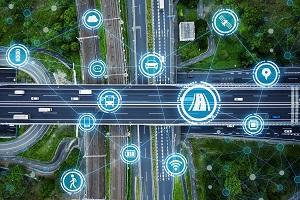
Intelligent Transport Systems can unlock major benefits in terms of safety, efficiency and environmental performance for mobility and the movement of goods. But with the rapid pace of innovation, ensuring interoperability and harmonization of technological solutions between countries remains a key challenge to realizing their potential at a large scale.
To address this, the UNECE Inland Transport Committee – the UN’s regulatory platform for road, rail and inland water transport – endorsed a new Road Map to guide the development of Intelligent Transport Systems.
An intelligent transportation system (ITS) uses information and communications technology solutions to provide integrated services relating to different modes of transportation. It can range from speed signs and other road infrastructure that monitor and adapt to changes in conditions and congestion, to vehicle-to-vehicle communications and autonomous driving technologies – where UN regulations play a key role –, and integration with rail and inland waterway transport. ITS is widely recognized as an efficient means of achieving efficient, safe and sustainable mobility.
The Road Map reflects the need for international harmonization, going beyond national and regional jurisdictions. When an insecure vehicle crosses the border of a member State, so do its vulnerabilities. When an incompatible vehicle crosses borders, this creates a safety concern. The spirit of this roadmap is to make sure that safety and security don't come as an afterthought but, rather, makes them a prerequisite for the trustworthy and reliable deployment of vehicles on roads in member States.
The rapid development of, among other aspects, communications technology has led to different voluntary standards being developed in neighboring countries, or even within the same country. Therefore, it is imperative to develop and implement guidelines, regulations and agreements on technical and technological compatibility to assure the safety of all road users. If there is no harmonization and interoperability between systems that are connected even when a border divides them, safety can be compromised. These innovative technologies must be seamlessly integrated into an intelligent transport system to ensure their safe and efficient operation, while simultaneously improving the safety and security of road users. Again, if these systems are developed without international harmonization, these technologies could pose a risk if crossing a border would compromise data security or even vehicle operability.
The UNECE Roadmap on Intelligent Transport Systems (ITS) and cooperation under ITC auspices can help ensure that millions of independent and unconnected systems don’t create additional barriers to cross-border trade or traveling. If the systems work cohesively together, then shipments and travelers move safely together.
The ITS Road map has in the past been updated and published on a 10-year schedule. However, ITC has committed to update the Road Map more frequently to respond to the rapid increase in technological development, particularly in the field of communications. The new Road Map outlines areas and activities that UNECE could prioritize in order to more quickly and broadly disseminate ITS applications.
This updated version of the ITS Road Map contains 18 Actions that aim to guide the work of the ITC in working on international application to ITS. They range from calling for international collaboration, to ensuring data security, to integrating with rail and inland water transport.
The launch of the updated UNECE Roadmap on Intelligent Transport Systems was part of the 83rd annual session of the ITC. The roadmap is available at: https://undocs.org/ece/TRANS/2021/15

